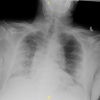Spontaneous pneumomediastinum, pneumothorax and subcutaneous emphysema in COVID-19 pneumonia: a rare case and literature review
- PMID: 33310838
- PMCID: PMC7735137
- DOI: 10.1136/bcr-2020-239489
Spontaneous pneumomediastinum, pneumothorax and subcutaneous emphysema in COVID-19 pneumonia: a rare case and literature review
Abstract
Spontaneous pneumomediastinum (SPM) and pneumothorax (PNX) unrelated to positive pressure ventilation has been recently reported as an unusual complication in cases of severe COVID-19 pneumonia. The presumed pathophysiological mechanism is diffuse alveolar injury leading to alveolar rupture and air leak. We present a case of COVID-19 pneumonia complicated on day 13 post admission by SPM, PNX and subcutaneous emphysema in a patient with no identifiable risk factors for such complication. The patient received medical treatment for his COVID-19 infection without the use of an invasive or non-invasive ventilator. Moreover, he is a non-smoker with no lung comorbidities and never reported a cough. He was eventually discharged home in stable condition. A comprehensive literature review revealed 15 cases of SPM developing in patients with COVID-19 pneumonia.
Keywords: infectious diseases; pneumomediastinum; pneumonia (infectious disease); respiratory medicine.
© BMJ Publishing Group Limited 2020. No commercial re-use. See rights and permissions. Published by BMJ.
Conflict of interest statement
Competing interests: None declared.
Figures




References
-
- WHO pneumonia of unknown cause – China. Available: https://www.who.int/csr/don/05-january-2020-pneumonia-of-unkown-cause-ch...
-
- Almeida JD, Berry DM, Cunningham CH, et al. . Virology: coronaviruses. Nature 1968;220:650.
Publication types
MeSH terms
LinkOut - more resources
Full Text Sources
Medical
